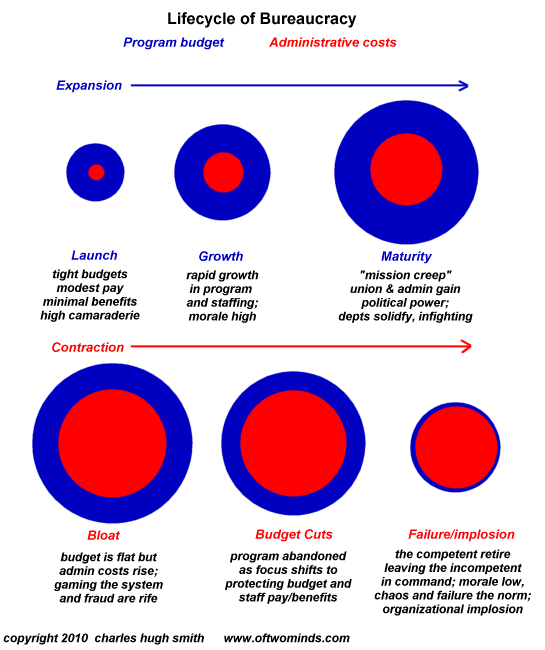Failure: Don't Despair, It's The New Normal
As our institutions fail, they will take down many individuals with them. Don't despair: the failure is systemic, not personal. As the U.S. economy fails on a systemic level, it is pushing individuals into a deep sense of failure. Feelings that one has failed one's family and oneself can feed a despair profound enough to trigger thoughts of suicide, and for many vulnerable people, thoughts lead to action. In a terrible irony, those who do take their own lives are often those with the highest sense of responsibility and highest personal standards; their sense of failure is crushing in ways that less responsible, more laissez-faire people cannot imagine. The systemic failure of the U.S. economy is pushing many to the brink of despair, as they interpret their own financial failures as personal rather than as the result of a system-wide decline stretching back decades. The need to explain this systemic failure is part of what drives me to write this blog day after day, month after month, year after year--to help people understand the roots of our national and global failings. Despite these multiple systemic failures, I am an optimist, and I wrote Survival+ to not only illuminate the roots of our institutional failures but to lay out guidelines for bypassing those institutions as they devolve and collapse. I have addressed this many times, for example: The Next Golden Age, Part I (July 28, 2010) The Next Golden Age, Part II (July 28, 2010) The Central State (Federal government) and the Federal Reserve are both failing institutions. Their policies, assumptions and mindsets have only one end-state: devolution and collapse. After the old institutions have imploded, some new sustainable, honorable version may arise; this is possible but not guaranteed. Nobody knows the future, and life is contingent. Institutions are like organisms: they have a life-cycle and exist in a wider ecology. Our current institutions are in the Failing Stage of their lifecycle, where simulacra "reforms" and facsimiles of "change" are presented in lieu of true systemic refomation. This strategy is based in the institution's politics of experience: real transformation would require their constituencies to lose some measure of income, power and perquisites, and since every fiefdom within the institution will deploy all its formidable resources to self-preservation, then real reform is rendered impossible. I have addressed this numerous times over the past five years, for example: What's Different Now (July 12, 2007) Complexity: Bureaucratic (Death Spiral) and Self-Organizing (Sustainable) (February 17, 2011) The Lifecycle of Bureaucracy (December 2, 2010) The basic mechanism of this expansion and fatal resistance to reform/change is "the ratchet effect": expansions of staff, reach, power and revenues are frictionless and exciting--the cog wheel of bureaucracy advances easily. But when the institution expands beyond its carrying capacity, beyond the efficiencies reaped from advancing complexity and scale, i.e. to mission creep, bloat and sclerosis, then any reduction in staffing, reach, power and revenues are resisted with iron fortitude and the desperation of an organism fighting for its life. I prepared this chart to illustrate the life-cycle of bureaucracy: As revenue declines and pressure for real reform mounts, the embattled institutions find that propaganda and facsimiles of reform are "cheaper" "solutions" than real reform. This is the key driver behind the flood of propaganda, bogus statistical "proof" of "recovery," and all the phony "reforms" laid out in 3,000 pages of befuddling bureaucratic self-preservation. Real reform would mean powerful constituencies would have to take real reductions in staffing, power, benefits and in their share of the national income. Rather than reveal this double-bind--reform is impossible but the Status Quo is unsustainable--the institution deploys its gargantuan resources to laying down a smoke-screen of bogus "reforms," distracting sideshows and ginned-up statistics to "prove" that "we're really changing things around here, yes-siree, and things are getting better and better, every day and in every way." But it's all deception and lies. Nothing has truly been changed or reformed; another layer of self-preservation has been added to an already bloated defense of perquisites and power. America's institutions are like stars about to go super-nova. They have increased in size to the point where their mass guarantees that once their energy source (as measured in fossil fuels and money) falls below a certain threshold, the institution will collapse inward on itself. Until then, the best that we can do is to avoid official entanglements, lower our own cost basis, pay off debt owed to the Death Star Financial System and reduce our dependency on the institutions which are currently expanding in the final stages before they go super-nova and implode. And don't take it personally if things fall apart around you. We're all doing our best, but we can't control everything around us. You are missed, E.M.K., every day: When an Old Friend Takes Her Own Life (December 1, 2007) Of Two Minds Kindle edition: Of Two Minds blog-Kindle
Readers forum: DailyJava.net.
Order Survival+: Structuring Prosperity for Yourself and the Nation (free bits) (Mobi ebook) (Kindle) or Survival+ The Primer (Kindle) or Weblogs & New Media: Marketing in Crisis (free bits) (Kindle) or from your local bookseller.Thank you, Vera K. ($5/mo), for your wondrously generous subscription to this site-- I am greatly honored by your longstanding support and readership. Thank you, Neil M. ($25), for your outstandingly generous contribution to this site-- I am greatly honored by your support and readership.























